- Italy Tours Home
- Italy Ethos
- Tours 2023
- Blog
- Contact Us
- Dolomites
- Top 10 Dolomites
- Veneto
- Dolomites Geology
- Dolomiti Bellunesi
- Cortina
- Cadore
- Belluno
- Cansiglio
- Carso
- Carnia
- Sauris
- Friuli
- Trentino
- Ethnographic Museums
- Monte Baldo
- South Tyrol
- Alta Pusteria
- Dobbiaco
- Emilia-Romagna
- Aosta Valley
- Cinque Terre
- Portofino
- Northern Apennines
- Southern Apennines
- Italian Botanical Gardens
- Padua Botanical Garden
- Orchids of Italy
The Cinque Terre National Park: Perfect Blend
of Nature and Culture in a Magnificent Setting.
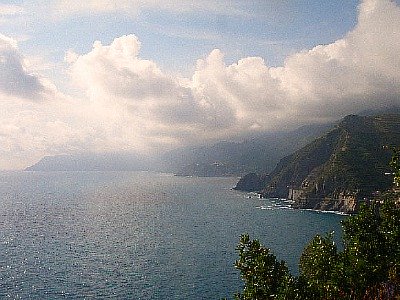
The Natural Environment
The Cinque Terre National Park was created with the aim to preserve the features of a unique environment in which nature and the work of man meet in striking balance, resulting almost in a work of art.
The nature of the Cinque Terre National Park has retained the value of an oasis that has preserved intact the characteristics of an uncontaminated natural environment over time (above, see an image of the whole arc of the Cinque Terre, contained between Punta Montenero – from where the picture is taken – and Punta Mesco, in the horizon).
The landscape and geology of the Cinque Terre National Park, formed by rocks of different origins and age, is characterized by a particular steepness and the relative lack of flat stretches. The coast – high and rugged – is incised by coves, with a few inlets and promontories, and carved by the sea into picturesque and suggestive natural coves. There are a few beaches – sandy and pebbly in nature – which are the result of detritus brought down by the local watercourses (mainly small streams and rivulets), as well as being the product of landslides or the deposit of other materials left by man.
The mountain chain lying at the back protects the coast from the cold northerly winds, while the warm and humid currents coming from the sea impact and rise against the slopes with the subsequent condensation of steam and vapors, creating the ideal conditions for the formation of mists and fogs at higher altitudes and on the ridge. Therefore, the mountains often appear shrouded in clouds; for the same reasons, rainfall is quite significant at higher altitudes, while at lower levels the climate is distinctly Mediterranean, with hot, dry summers and mild, wet winters.
The Cinque Terre National Park is the natural habitat for several species – both in terms of flora and fauna – that find here the ideal conditions in which to live and reproduce themselves.
In regards to the flora, this orographic complexity has led to a variety of micro-climates, with the subsequent diversification of vegetation. Holm oak (Quercus ilex) woodland has been in part substituted with cultivated strips of other tree species such as Maritime pine, Aleppo pine, Cork oak and Chestnut. In the habitats close to the sea shore, sea fennel and rock samphire (Crithmum maritimum) grow close to caper plants (Capparis spinosa), which were actively cultivated in the past. In the more rocky habitats, beside the silver ragwort (Cineraria maritima) and other ragwort species (such as Senecio bicolore), are sturdier aromatic plants such as Common Rue (Ruta graveolens); in the wider cracks of the rocks one can find the frequent Tree Spurge (Euphorbia arborea), as well as numerous other plants belonging to the so-called “macchia mediterranea”.
Within the area covered by the Cinque Terre National Park, all those aromatic shrubs normally associated with the Mediterranean habitats – such as rosemary, thyme, elychrisum and lavender – are common. In terms of shrubs, ‘macchia’ (‘maquis’) heather and tree heather, as well as a mixture of other plants typical of the ‘maquis’ (formed mainly by mastic – lentisco in Italian –, myrtle, terebinth, several brooms, strawberry tree, Phyllirea and red juniper) dominate, creating dense thickets. These are entangled with creeping and often spiny plants such as bryony, madder, Traveller’s joy (Clematis flammula), wild asparagus, Etruscan Honeysuckle and Sea Honeysuckle to form an impenetrable undergrowth.
The Human Environment
The Cinque Terre National Park covers a stretch of 15 km of overhanging cliffs along the coastline of eastern Liguria (“Liguria di Levante”). Specifically, the name Cinque Terre was given in origin to the five sea towns of Monterosso, Vernazza, Corniglia, Manarola and Riomaggiore, which are roughly situated at the same distance from one another, clutched to the rock and often hidden into narrow and steep valleys.
The name ‘terra’ (literally, earth or land) is here to be intended rather as synonym of ‘quarter’, in the Medieval sense of the term (i.e. strip of land). Human activities contributed to create a unique landscape which is the expression of a culture deeply linked to – and seeped into – the place that generated it: a collective experience able to master the adversities of the natural environment in relation to the needs of the people.
The encounter between man and nature has resulted here in the improvement and valorization of the territory that is now part of – and protected by – the Cinque Terre National Park. In order to survive, for about one thousand years man has shaped these harsh and steep mountain slopes – falling sheer into the sea – by developing cultivated strips of land in places which were covered in the past by thick woodland.
Generation after generation, man has broken the rock to build kilometres of impressive dry stone walls, thus giving life to an ‘artificial’ landscape made of terraces. Over these terraces, from the cultivation of vineyards – a very demanding activity, given the steepness of the slopes and the difficulties in moving and carrying materials around – an excellent wine was produced, which has now made a comeback after a period of neglect, and is again well renowned for its high quality. But that of cultivating vines is not the only activity that links man to this land: beside the vineyards, lemon, Olive and fruit trees are also being cultivated in orchards .
It is a landscape historically tended with patience and care, so to give the territory of the Cinque Terre National Park an even more unique aspect. The sinuous terraces envelops the hills as a green belt, and soar high above the azure sea. Even the small towns and villages show that the relationship of man with nature has happened here without causing major traumas: the inhabited landscape developed respectfully as regards to the natural environment, safeguarding it from the excessive invasion of built-up areas. The routes and trails that were created over the centuries are essential, and instrumental in reaching the steepest locations within any individual slope; most of these paths can only be walked on foot, and cannot be accessed with any other vehicle.
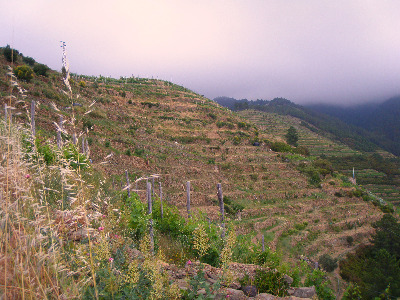
The Work of Terracing
As we have just seen, during the course of about one thousand years of history man has replaced the original woodland which covered these steep mountain slopes with the cultivation of vineyards in terraces (see image above), made possible through the shattering of the bedrock, and the creation of many kilometres of dry-stone walls and cultivated land.
From the first century AD through to the Low Middle Ages, and all the way up to the present day, the struggle between man and his environment here has been continuous, and it has led to the shaping of the landscape through its reconstruction after every landslide or erosion caused by rain; the good quality of the rock and the development of skills to build dry-stone walls guaranteed over time an ever greater resistance to the falls.
Among the terraces there are very long and steep stairs built across the walls, with places where to lean the materials carried on shoulder, and small canals at the side of the mule tracks: all signs of the intense human activities that took place on these slopes. This colossal enterprise has been carried out thanks to the work of many generations, and it has been handed down through the will to render productive an area which otherwise it would not have been possible to cultivate.
For centuries, though, the farmer of the Cinque Terre has been not only the producer of a precious wine, but above all the warrant of the hydrogeological stability of this precious landscape, which otherwise would not have reached us in these conditions, and that has today been recognized as a World Heritage Site. The maintenance of this territory and the defense of its features are thus entrusted to the operations linked to agricultural practices; in fact, degradation immediately follows the abandonment of these places by man. Thus, even if the terracing has been carried out by the population of the Cinque Terre since the year 1000 with productive aims, it has also led to effects which overcame the original goal – such as the hydrogeologic stability of the mountain slopes and the subsequent safety of the underlying villages, as well as the general connotation of this landscape.
The recently changed economic and social balance has influenced the territory of the Cinque Terre National Park following the abandonment of the traditional cultivations, which guaranteed the safeguard of the area in the first place. If this process is allowed to become irreversible, the consequence would be the fast degradation of the soil, leading to increasing landslides menacing the towns, the impossibility to exploit wide sections of territory for agricultural purposes, irreversible changes in the landscape features, and – ultimately – the subsequent loss of a unique historic landscape.
This system of terraces has been built, starting from year 1000, solely out of stone and earth – nothing here has been imported: the constituent material of the dry stone walls is mainly local sandstone, dug and worked in situ when the pieces of rock were too big to be moved about. The little soil that could be found locally was accurately sieved and accumulated over the terraces – above a layer of earthed vegetation – with the aim of enriching the humus. Such a system of leveling the soil, as well as permitting the obtainment of narrow strips of arable land – called ciàn in the local dialect – has allowed the regulation of hydro-geological fluxes, as well as helping to direct the natural course of the meteoric water.
Over the course of the centuries, this terraced arrangement has reached the maximum surface of around 2,000 hectares, mainly covering the altimetric band that goes from the sea to about 4-500 metres above sea level, starting in some cases very close to the shore. Despite the vast portions interested by terraces, conditions of work were extremely harsh for farmers, especially because of the difficult – and often impossible – mechanization of the agricultural work. Vineyards, olives and citrus fruits (the main products of the area, with a decisive predominance of grapes) have been – and still are – cultivated with the ancient knowledge of centuries ago, with very little modification in response to the technological innovations that have taken over farming practices in other parts of the country (the difficulty of access of the cultvated sites has naturally prevented the use of machinery).
To conclude, this monumental work of man – who has modeled the verticality of these mountain slopes in an enormous number of minute strips of arable land, each of which is supported by a dry stone wall – is threatened today by abandonment. Such a system, if it is not constantly maintained and kept effective, goes in fact towards a process of natural degradation, often irreversible. To contrast this decline, the Cinque Terre National Park – right from the moment of its foundation – has launched an extensive plan of interventions aimed at the protection and conservation of this most important historical and cultural heritage, which is in fact what makes the Cinque Terre a unique place (below, see an image of Riomaggiore, one of the starting points of the coastal path).
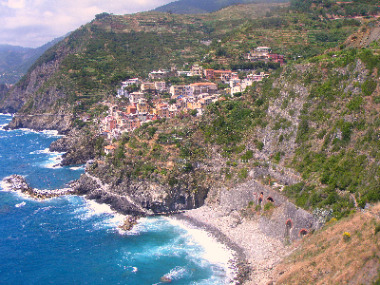
The Sentiero Azzurro Coastal Path
The Sentiero Azzurro (Blue Trail) coastal path connects all the villages of the Cinque Terre and is by far the most popular walking route within the whole Cinque Terre National Park; its first part, Riomaggiore to Manarola – known as the Via dell’Amore (Love Lane) – turns out to be the most frequented stretch.
It takes a good pair of legs eight hours to walk the whole trail, even though it is possible (and advisable) to break it into sections, described below. The fatigue is abundantly repaid by the unique views, characterised by a background of cliffs falling sheer into the sea and accompanied by the scents of the maquis or garrigue – the typical Mediterranean scrubland composed of aromatic plants and herbs, alternated by the fascination of the many small, isolated inlets. It is an experience which, in my view, has to be done with the necessary calm – not forgetting a halt in one of the villages for a tasting of the local cuisine and the famous wines of the Cinque Terre.
First stretch: from Riomaggiore to Manarola
Dug into the rock between 1926 and 1928, the first section of the trail (the Via dell’Amore mentioned above) was originally used by railway workers to move between Riomaggiore and Manarola railway stations – which were then under construction – on foot. Today it is a pleasant and romantic walk, suitable for everyone. Roughly halfway – but slightly closer to Manarola – is the so-called Bar dell'Amore, a café perched high on the rocks with a sea-view terrace, while at its very beginning – still in Riomaggiore – is A Pie de Ma (meaning literally at the foot of the sea in the Ligurian dialect): another bar/restaurant with an amazing suspended terrace, where one can sample local dishes while enjoying the sweeping sea-views (below, an image of the impressive rocks along the Via dell’Amore).
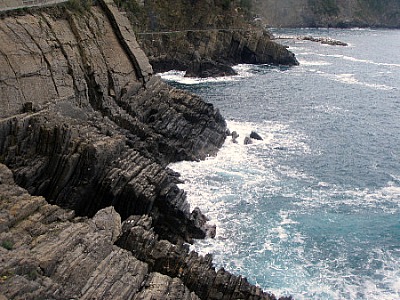
Second stretch: from Manarola to Corniglia
The section from Manarola to Corniglia starts at Manarola railway station, where there is also a refreshment point and a visitor centre selling local produce from the park; the route then passes under the railway tunnel and heads towards the marina, where two possibilities open up: one can either take the ancient uphill paved trail passing by the cemetery, or choose the sea-view walk known as Birolli di Punta Bonfiglio up to the Palaedo depot, and from there continue on the new “Sentiero delle Trasparenze Marine” (the ‘Trail of Marine Transparencies’) until one rejoins the original trail (marked no. 2) by the hamlet of Laghi.
There the track becomes gentle, as it stretches beside the whole length of the underlying Spiaggione di Corniglia – the wide beach of Corniglia. Beyond the railway underpass, the trail eventually reaches Corniglia railway station, soon after which is the beginning of the Lardarina staircase that climbs to the uphill town of Corniglia itself (below, an image of the terracing around Corniglia, hosting vineyards, Olive and fruit groves).
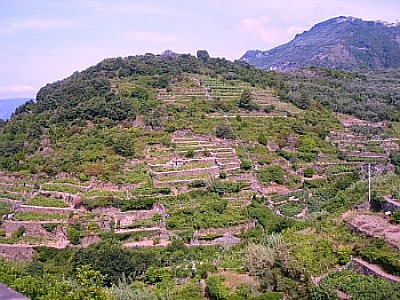
Third stretch: from Corniglia to Vernazza
For the following stretch – Corniglia to Vernazza – one first takes the carriage road in Corniglia and crosses the Ponte del Canale, under which flows the Rio della Groppa. After walking along the walls of Casa Zattera and crossing an olive grove (where the trail climbing to Case Fornacchi starts), one reaches a charming panoramic viewpoint overhanging the Guvano beach (Spiaggia di Guvano). After skirting the whole of Guvano bay – where along the way is a small spring under the road and a picnic area – the path climbs to the highest point of the “Sentiero Azzurro” by the village of Prevo (208 meters), which also offers a small refreshment point. The trail then starts heading downhill (the first stretch has steep steps); the descent towards Vernazza is among pleasant olive groves and vineyards (below, an image of the coastal path descending into Vernazza).
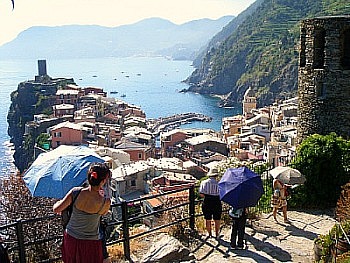
Fourth stretch: Vernazza to Monterosso
Vernazza to Monterosso is the last section of the coastal path. From the main square in Vernazza one first passes under an arch, then takes the panoramic trail uphill towards Costa Messorano. Among vineyards and olive groves across the small Cravarla valley – between 150 and 200 meters of altitude – one then continues along Costa Linaro to the little valley of Fosso Mulinaro, eventually reaching the basin of Acquapendente, where some resident families still cultivate olives, vineyards, lemons and vegetables. A bridge crosses a small stream which, immediately after, falls into the sea from a high rocky wall.
Past Acquapendente starts a steep staircase surrounded by vineyards and lemon gardens protected by high walls headed towards Punta Corone; then, the downhill section of the trail leading to Monterosso begins, which later splits into two branches: taking to the right, one can head straight towards town, with arrival in the central Piazza Garibaldi, while the left branch will skirt the Corone cliff and reach the limit of the beach. In piazza Garibaldi the two trails join up together towards Fegina, where the official terminus of the Sentiero Azzurro is in front of the railway station (below, an image of the final descent of the coastal path into Monterosso, with Punta Mesco in the distance).
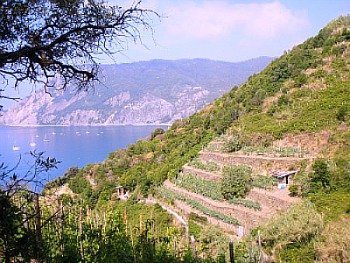
Other Trails and Trekking
The Ridgeway (Sentiero no.1 or Sentiero 5T)
The trail that from Portovenere goes along the high ridge which divides the coastal side from the internal side all the way to Levanto – over Punta del Mesco – is considered the path of the Cinque Terre almost by definition. It is a smooth but long trail (about 40 km, half of which is contained within the boundary of the Cinque Terre National Park), recommended to sufficiently trained and equipped hikers; otherwise, it is possible to cover only a stretch of this medium-distance trail, choosing perhaps the most panoramic sections, and head down via one of the several paths that cut diagonally to the various villages of the Cinque Terre.
The “Trail of the Sanctuaries”
Considering the particular orographic and morphological features of this territory, the trails of the Cinque Terre National Park can be considered in all respects similar to mountain trails, most of which are without any protection, with sometimes considerable differences in height and several exposed tracts. The trail bottom also varies according to weather conditions, and it can sometimes be uneven or muddy, so adequate clothing and appropriate footwear is required; in a word, these paths should not be undertaken lightly.
One of the most interesting of such paths is the so-called “Trail of the Sanctuaries” (Sentiero dei Santuari), which not only crosses an enchanting territory, but also covers a long stretch of history. Once the peasant world of the Cinque Terre was as important as the maritime world, so it is not by chance if the Route of the Sanctuaries (which are five; one for each village, listed below) winds up the mountain tops, as a witness to its ancient origins.
As a matter of fact, according to some researchers, part of this route may correspond to an ancient track dating to the Bronze Age (1,800-900 BC), as demonstrated by the presence of menhirs in Volastra and Tramonti – probably linked to the presence of a Ligurian civilization settlement, to which also the two box-shaped tombs found in Soviore and on Monte Santa Croce could be ascribed.
The oldest sanctuaries are situated above Monterosso (Madonna di Soviore), Vernazza (Nostra Signora di Reggio) and Volastra (Madonna della Salute), while the religious buildings above Corniglia (Nostra Signora delle Grazie e di San Bernardino) and Riomaggiore (Nostra Signora di Montenero) are more recent.
The route, developed along the mountain side and connecting all these different places of worship, is an open invitation to acknowledge oneself with this amazing territory through history, by crossing charming locations which are also very important in terms of the origins of the Cinque Terre (these lands were first worked by monks). But leaving history aside, even the most distracted walker will not fail to be stunned by the majestic views that open up along the way, sweeping from the coastal inlets to the faraway sights – on clear days – of the Tuscan Archipelago and even the distant island of Corsica.
In Case Pianca, above Corniglia – in the medium-high altimetric band of the Cinque Terre National Park (that can be reached also by using the Park's public means of transport) – horses and carriages can be rented for pleasant rides along trails and side roads, across Holm oak and pinewood thickets, while enjoying the views over the coast. Along the tracks, there is always an opportunity to stop and taste local dishes or sample the D.O.C. wines (such as the famous Sciacchetrà), produced with the grapes cultivated in the ever-present vineyards overhanging the sea, and – should one wish to – is it also possible to spend the night in the guest house of an ancient Sanctuary or in one of the other off-road structures, such as the Agriturismi (accommodation in a working farm).
Local Products
In 2006, the Cinque Terre National Park entrusted the production of salted anchovies to the Co-operative Le Ragazze del Parco which, thanks to the teaching of the elderly, has recovered and enhanced this gastronomical specialty from the Monterosso tradition. Known as “pan do ma” (the Bread of the Sea), anchovies are fished locally with the lampara net traditional method and processed by hand within two or three days in the salting workshop in Levanto. Thanks to the careful arrangement in layers, adequate pressing, a careful brine quantity and quality monitoring, the anchovies remain compact and tasty, and can be perfectly preserved, so that the final product maintains all the aroma and taste of fresh fish. Anchovies are very good with Olive oil, oregano and garlic for an excellent appetizer, but they are also ideal as a dish in their own right. In fact, a round sandwich (focaccia), garnished with anchovies and seasoned with Olive oil and dried herbs, makes for a typical quick lunch in this area.
One of the other most popular products from this area is Limoncino – the famous liqueur which is obtained exclusively with lemon rinds from the Cinque Terre, steeped in organic alcohol a few hours after the harvesting. This simple and immediate processing method maintains the aromatic and digestive properties of lemon, so that the final product retains the fruit essence and its active properties. It is a sweet liquor with a strong but agreeable taste.
Perhaps, the product that more than anyone else symbolizes the area of the Cinque Terre National Park is the aforementioned Sciacchetrà – a legendary sweet wine obtained solely out of the local low vineyards. But despite the great demand and its being almost an emblem of the region, real Sciacchetrà is nowadays almost impossible to find, as it tends to get adulterated in different ways. For this reason, it is important that such considerable cultural evidence continues to exist as an authentic product, as it risks to succumb under commercial requests that have nothing to share with the original culture of the Cinque Terre over the centuries. For this reason, when in the Cinque Terre, if you want to buy 'Sciacchetrà' make sure it comes from a certified source (the best guarantee is to look for the mark given by the Park). Also, there is a small museum in Manarola documenting the history – and the production stages – of this legendary product.
Besides the historical cultivations (especially of vineyard and olive groves), careful management of other local resources is one of the Cinque Terre National Park’s main aims: from aromatic herbs in perfumery to chestnut processing in gastronomy, there is the possibility to create a number of micro-activities to revive the territory, while at the same time promoting an economic perspective which favors the active maintenance of the land.
The Park authority has actively aimed at enhancing these activities with the creation of a workshop where the local herbs are transformed into essences and other cosmetic products – and this facility can also be visited, just beside Manarola railway station (by the visitor centre). In connection to this, an important project lies in the progressive reintroduction of naturopathy techniques, as well as of health prevention and education; in fact, one of the Cinque Terre National Park’s main goals is to become a reference point for a cultural tourism that looks for holistic (psychological and physical) health, which is linked to the Park’s essential mission of respecting the environment through a lifestyle in harmony with the natural laws, leading in turn to a better quality of life.
The model of eco-compatible development provided by the Park does not deal only with the naturalistic and marine biology aspects, then, but with the whole of the Cinque Terre National Park’s ecosystem, which was shaped and preserved – as we have seen – thanks to the menfolk who settled here in the first place, and developed their culture in strict relationship to the natural environment.
As a matter of fact, naturopathy includes all those branches of natural medicine – sometimes called 'complementary' and at other times 'alternative' – which are based on a very ancient knowledge of nature by humans, as revised and implemented by modern science and technology. Ultimately, it can be said that the most important goal of the Cinque Terre National Park is to initiate a general process of sustainable development by improving the quality of life of the individuals – be they residents or visitors of the Park – and by trying to demonstrate that economic competitiveness and environmental compatibility are not one against the other, but can find a way to blend while aiming to strike the right balance.
The ‘Park of Man’ in Context
Today in Italy there are 22 National Parks, which amount – on the whole – to more than 1,5 million hectares of land, covering about 5% of the national territory. The Cinque Terre National Park plays a vital role within this network, while displaying – if confronted with other similar realities in the country – some atypical features that make it unique in its kind. To begin with, it is in fact the smallest National Park in Italy, while being at the same time the most densely populated, with about 5,000 inhabitants subdivided among five localities belonging to three municipalities. Its main differentiating aspect is given precisely by the fact that here the natural landscape has been heavily influenced by the presence of man.
As we have seen, for centuries – starting from around year 1000 – in order to obtain arable strips of land, the inhabitants of the Cinque Terre have worked the steep mountain slopes that drop sheer into the sea. These relatively flat strips – known locally as ciàn – are supported by dry stone walls that have made the Cinque Terre known worldwide, while forming its real identity trait. The human intervention has thus created a terraced – and therefore 'artificial' – landscape, mostly developed vertically, which makes this territory atypical and heavily shaped by man: this is why the Cinque Terre National Park has now become known as the “Parco dell’Uomo” (the ‘Park of Man’).
The Cinque Terre National Park puts at the centre of its action the defense of this peculiar landscape which, because of the physiological abandonment of agricultural activities following the advent of industrial societies, was threatened by phenomena of degradation. If, in most other circumstances, parks are created with the ultimate goal of defending the natural environment from the encroachment of human activities, here the reality is quite different – and almost opposite, as the main goal of the Park authority (“Ente Parco”) is that of bringing man back to interact with the landscape he created by cultivating and tending it – but with a renewed awareness – thus following in the footsteps (and rediscovering the ancient gestures) of those who have contributed before us to make the landscape of the Cinque Terre a unique UNESCO World Heritage Site (in the closing image below, an image of Vernazza from the coastal path, emblematic of a perfect balance between nature and culture).
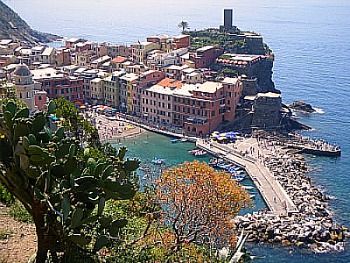
Update as of June, 2014. Please note the following important information.
The Coastal Trail (formerly Sentiero Azzurro) is closed at the moment in the stretch between Riomaggiore and Vernazza for reasons of safety; only the last section (Vernazza to Monterosso) is open to the public for walking. In alternative one can take the upper sections that connect the various villages via the higher routes, which are as rewarding in terms of sights, although often more demanding as hikes (as an example, Corniglia can be reached from Manarola via Volastra).
Notice also that the local branch of CAI is in the process of renumbering all the trails, and even the former Sentiero Azzurro is now being marked with the usual CAI red-white-red stripes, and given a new number).
Return from Cinque Terre National Park to Cinque Terre
Return from Cinque Terre National Park to Italy-Tours-in-Nature
Copyright © 2012 Italy-Tours-in-Nature

New! Comments
Have your say about what you just read! Leave me a comment in the box below.